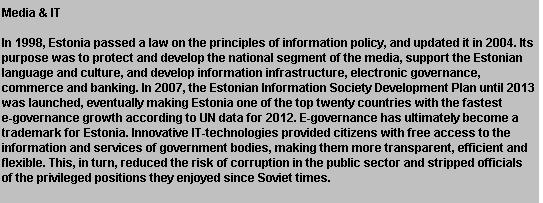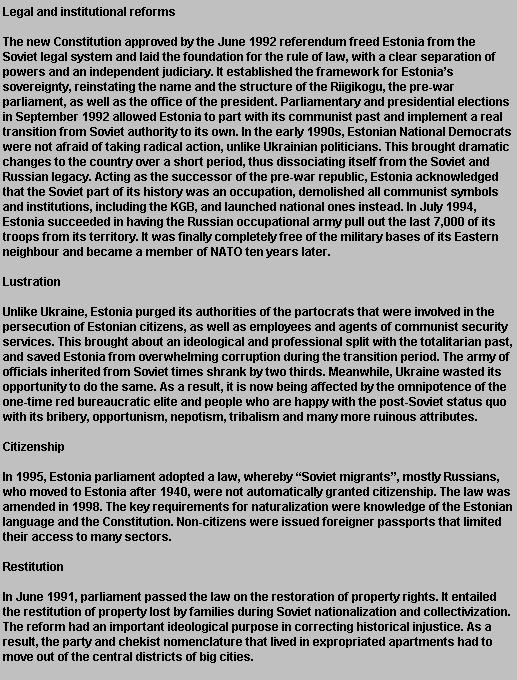When speaking in Kyiv in March I referred to the de-Sovietization of Estonia as the beginning of the process of accession to the European Union and NATO. To be more precise, I should have described it as a "restoration" or even "resurrection". Why? Because everything Estonia did at the beginning of the nineties revolved around the pre-war republic (1918 – 1940). Consequently, Estonia thought more of recovery than destruction. Or, to be more precise again – everything was about replacement.
Historically, Estonia and Livonia had played the role of a "window to the West" in the Russian Empire. The Baltic Germans filled important posts in the Czarist administration and the literacy rate was highest among Estonians in the late Empire. In this respect, Estonia and Estonians have always viewed themselves as part of European civilization and recovery of the pre-war republic in 1991 meant a return to the Western world rather than knocking on the door of Europe. "We were always there, the Cold War just meant that we were temporarily cut off from the rest of the continent" – that was the main line of thinking.
READ ALSO: Estonia: the Importance of Being Re-Independent
The experience of the pre-war republic definitely alleviated Estonians' fears that they would not survive alone for long. The stories according to which the demise of the Soviet Union paved the way for an uncertain future were still prominent and many sceptics thought a reunion with Russia would be the only way out. Complete independence seemed a dangerous and destructive path forward.
This was not true for Estonia. The 22 years of pre-war independence had given the restorateurs of the Estonian state enough confidence that Estonia could survive. But perhaps only a few understood that the window of opportunity, i.e. the temporary weakness of Russia would have to be exploited to the maximum extent possible.
This exploitation meant first and foremost the securitization of economy. The word securitization comes from the Copenhagen Security School and means that once something is securitized in society, it is beyond any discussion. That process happened in Estonia with regard to the economy. Since NATO membership in the 1990s was perhaps only in the minds of the maddest dreamers, the only way to guarantee security was through EU membership. And that meant very rapid economic reforms.
READ ALSO: Estonia's The New Constitution: A Normal Life Begins
In addition, the knowledge and experience of the pre-war republic meant that no wheel needed to be invented. Of course, exactly how was it to happen and what technicalities would be involved – this was all open for discussion, but basically post-Soviet Estonia knew the basics of a democratic country.
And the “accessories” of a democratic country are the Constitution, the rule of law, the separation of powers and the protection of private property. All those fields were covered by reforms in the beginning of the 1990s.
In Kyiv, I was asked how Estonia got rid of the KGB and why there were no holdovers from the Soviet time regarding the security services. The answer is the same – nothing from the Soviet administration and its institutions was to stay intact. In the pre-war republic, the Estonian secret service was called "political police", now it was renamed "defence police". At any rate, the KGB had to go.
The securitization of the economy, however, might have remained an empty slogan had Mart Laar’s first government not carried out very strong and decisive reforms. Those reforms laid the foundation for the Estonia we know today. Unlike many other Eastern European countries, Laar’s government meant a real U-turn from the left to the right. Laar was (and still is) very strongly anti-communist, so the government got rid of the Soviet legacy as much and as quickly as possible.
Russia actually contributed much to Estonia’s break-up with the Soviet legacy and the country's decisive path towards the West. It has to be remembered that when the Soviet Union dissolved, the Baltic States and Russia were in the same boat. After the bloodshed in Vilnius in January 1991, hundreds of thousands of people took to the streets in Moscow to show their solidarity with Lithuania. Nonetheless, perhaps one of the most crucial questions to be asked with regard to Russo-Baltic relations from 1991 on is what went wrong and why Russia had tension with her reborn neighbours as early as 1992. One possible explanation is the way that Russia understood the independence of the Baltic States – Russian leaders wanted those states to be only semi-independent and still greatly depend on Russia. Yet Baltic States themselves understood independence as quite the opposite – a total break-away from Russian influence.

READ ALSO: So, There Was an Occupation, But No-one Did the Occupying?
Consequently, Russia was not very keen to withdraw its troops from the Baltic States. However, the Baltic States were considered to belong together with the rest of the Eastern European countries and finally Russia had to comply. The date of August 31, 1994, was a landmark event for Estonia when the Second World War came to an end and the last Russian soldier left Estonia. No doubt, the withdrawal of Russian troops paved the way for Estonia's eventual membership in the EU and NATO.It has to be remembered that when the Soviet Union dissolved, the Baltic States and Russia were in the same boat. After the bloodshed in Vilnius in January 1991, hundreds of thousands of people took to the streets in Moscow to show their solidarity with Lithuania. Nonetheless, perhaps one of the most crucial questions to be asked with regard to Russo-Baltic relations from 1991 on is what went wrong and why Russia had tension with her reborn neighbours as early as 1992. One possible explanation is the way that Russia understood the independence of the Baltic States – Russian leaders wanted those states to be only semi-independent and still greatly depend on Russia. Yet Baltic States themselves understood independence as quite the opposite – a total break-away from Russian influence.
Nevertheless, Russia tried to keep some leverage on Estonia. In 1995, as a reactionary measure against the alleged mistreatment of the Russian minority in Estonia, Russia imposed double custom tariffs on Estonia practically closing her market to Estonian producers. But the latter did not sit idly by, but turned eyes toward Western Europe. Of course, this was not easy: the competition was tougher and Estonian producers did not know at first how to advertise their goods. But the process had started and it meant another step away from the Russian sphere of influence and one more step towards the West. For those who had their doubts regarding the Western market, the Russian crisis of 1998 was of decisive importance.
The year 1995 also marked the first major step towards the EU when Estonia signed an Association Agreement with the Union. In 1997, a more important event followed when Estonia became the first country of the former U.S.S.R. to be invited to EU accession talks. The decision was a clear sign to Russia that the EU would not play the game of spheres of influence and was ready to take in countries from behind the former Soviet border. An additional explanation comes from NATO enlargement. In 1997, Poland, Hungary and the Czech Republic were invited to NATO accession talks and the West was keen to show Russia that the Baltic States were not a foregone conclusion or eventually to be in the Russian sphere of influence. The EU invitation to Estonia was a clear sign of the opposite.
READ ALSO: The Price of Egoism
From 1998 to 2002, Estonia negotiated with the EU on terms of accession. In 2003, Estonia had a referendum on EU membership with two thirds of voters in favour. In 2004, Estonia became a member of the EU. In 2007, the country joined the Schengen visa zone. In 2011, Estonia became the 17th member of the eurozone. In 2018, Estonia will hold the presidency of the EU. The road to the EU has integrated Estonia even more strongly into the West.
The same can be said for NATO. In the 1990s, NATO was quite reserved with regard to the Baltic States as Western leaders were cautious not to irritate Russia. However, the Baltic States’ silent and fluent movement toward NATO came to an abrupt end when the U.S. experienced 9/11. The U.S. needed allies quickly and of course NATO membership was a strong carrot to motivate Eastern European nations. In 2002, Estonia received an invitation to join the alliance and two years later Estonia was admitted to NATO.
Being with the West also means having the problems of the West. The crisis inside the euro-zone and austerity have created a discussion about the future of the EU. This discussion is also a topic inside Estonia – if the EU is to exit the crisis (and the signs are there that it will) it would be good to know where to exit. We do not know what the EU would look like in several years' time, but we can be more than certain that Estonia will be part of it. "Restoration" or "resurrection" has been replaced by the future.



Erkki Bahovski works for the European Commission Representation in Tallinn. The article expresses his personal views

